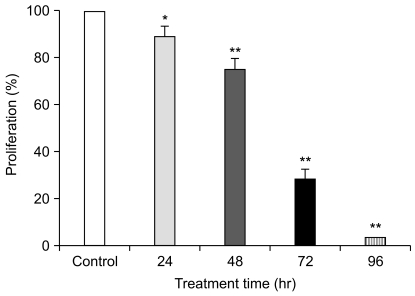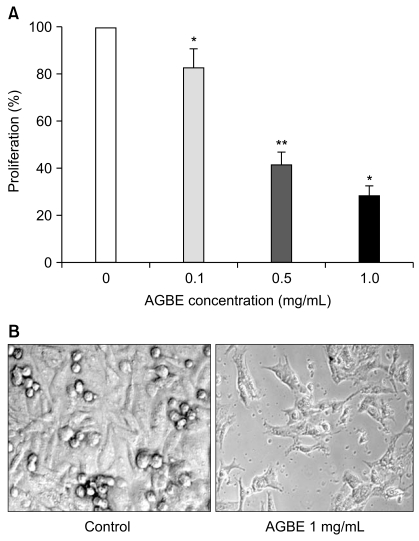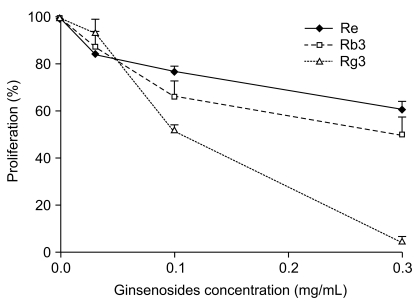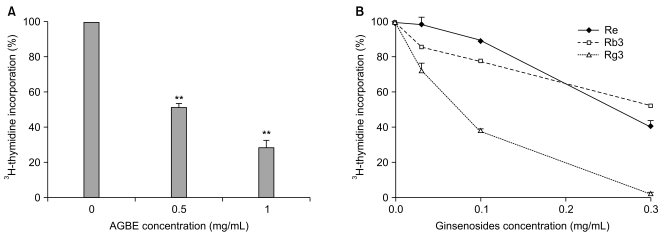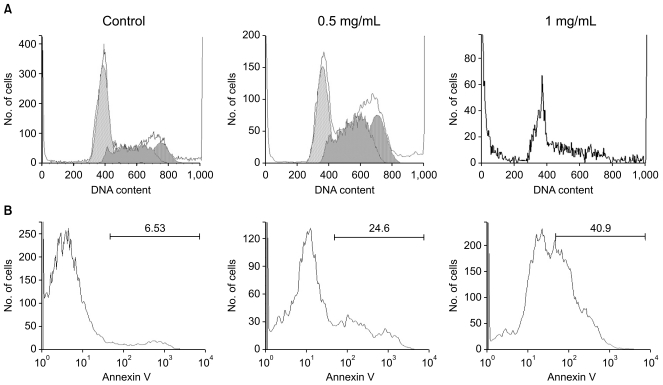Cancer Res Treat.
2011 Mar;43(1):49-55.
Effects of Triterpenoid Glycosides from Fresh Ginseng Berry on SW480 Human Colorectal Cancer Cell Line
- Affiliations
-
- 1Tang Center for Herbal Medicine Research, University of Chicago, Chicago, IL, USA. CYuan@uchicago.edu
- 2Department of Anesthesia and Critical Care, University of Chicago, Chicago, IL, USA.
- 3Committee on Clinical Pharmacology and Pharmacogenomics, University of Chicago, Chicago, IL, USA.
Abstract
- PURPOSE
The pharmacological activities, notably the anticancer properties, of bioactive constituents fromfresh American ginseng berry have not yet been well studied. In this study, we investigated the antiproliferative effects of fresh American ginseng berry extract (AGBE) and its representative triterpenoid glycosides using the human colorectal cancer cell line SW480.
MATERIALS AND METHODS
Using high performance liquid chromatography (HPLC), the contents of 8 ginsenosides in AGBE were determined. The cell growth inhibitory effects of AGBE and three triterpenoid glycosides (ginsenosides Rb3, Re, and Rg3) were evaluated by proliferation assay and 3H-thymidine incorporation assay. Cell cycle and apoptotic effects were analyzed by using flow cytometry after staining with propidium iodide and annexin V.
RESULTS
HPLC analysis data showed that AGBE has a distinct ginsenoside profile. AGBE inhibited SW480 cell growth significantly in a time-dependent (24-96 hours) and concentration-dependent (0.1-1.0 mg/mL) manner. Ginsenosides Rb3, Re, and Rg3 also possess significant antiproliferative activities on SW480 cells. 3H-thymidine incorporation assay indicated that AGBE and ginsenosides Rb3, Re, and Rg3 might inhibit the transferring and duplication of DNA in SW480 cells. Flow cytometric assay data suggested that AGBE arrested SW480 cells in S and G2/M phases, and significantly induced cell apoptosis.
CONCLUSION
AGBE and ginsenosides Rb3, Re, and Rg3 possessed significant antiproliferative effects and induced changes of morphological appearance on SW480 cells. The mechanisms of the antiproliferation of AGBE and tested ginsenosides involved could be cell cycle arrest and induction of apoptosis.
Keyword
MeSH Terms
Figure
Reference
-
1. Jemal A, Siegel R, Ward E, Hao Y, Xu J, Thun MJ. Cancer statistics, 2009. CA Cancer J Clin. 2009; 59:225–249. PMID: 19474385.
Article2. Bingham SA. Diet and colorectal cancer prevention. Biochem Soc Trans. 2000; 28:12–16. PMID: 10816091.
Article3. Moertel CG, Fleming TR, Macdonald JS, Haller DG, Laurie JA, Tangen CM, et al. Fluorouracil plus levamisole as effective adjuvant therapy after resection of stage III colon carcinoma: a final report. Ann Intern Med. 1995; 122:321–326. PMID: 7847642.
Article4. O'Connell MJ, Mailliard JA, Kahn MJ, Macdonald JS, Haller DG, Mayer RJ, et al. Controlled trial of fluorouracil and low-dose leucovorin given for 6 months as postoperative adjuvant therapy for colon cancer. J Clin Oncol. 1997; 15:246–250. PMID: 8996149.5. Aung HH, Wang CZ, Ni M, Fishbein A, Mehendale SR, Xie JT, et al. Crocin from Crocus sativus possesses significant anti-proliferation effects on human colorectal cancer cells. Exp Oncol. 2007; 29:175–180. PMID: 18004240.6. Moon PD, Koo HN, Jeong HJ, Na HJ, Kim SJ, Hwang GS, et al. Haeamtang induces apoptosis of colon cancer HT-29 cells through activation of caspase-3. Am J Chin Med. 2007; 35:897–909. PMID: 17963328.
Article7. Attele AS, Wu JA, Yuan CS. Ginseng pharmacology: multiple constituents and multiple actions. Biochem Pharmacol. 1999; 58:1685–1693. PMID: 10571242.8. Ang-Lee MK, Moss J, Yuan CS. Herbal medicines and perioperative care. JAMA. 2001; 286:208–216. PMID: 11448284.
Article9. Xie JT, Mchendale S, Yuan CS. Ginseng and diabetes. Am J Chin Med. 2005; 33:397–404. PMID: 16047557.
Article10. Wang CZ, Mehendale SR, Yuan CS. Commonly used antioxidant botanicals: active constituents and their potential role in cardiovascular illness. Am J Chin Med. 2007; 35:543–558. PMID: 17708622.
Article11. Helms S. Cancer prevention and therapeutics: Panax ginseng. Altern Med Rev. 2004; 9:259–274. PMID: 15387718.12. Wang CZ, Aung HH, Ni M, Wu JA, Tong R, Wicks S, et al. Red American ginseng: ginsenoside constituents and antiproliferative activities of heat-processed Panax quinquefolius roots. Planta Med. 2007; 73:669–674. PMID: 17538869.
Article13. Kitts D, Hu C. Efficacy and safety of ginseng. Public Health Nutr. 2000; 3:473–485. PMID: 11276295.
Article14. Radad K, Gille G, Liu L, Rausch WD. Use of ginseng in medicine with emphasis on neurodegenerative disorders. J Pharmacol Sci. 2006; 100:175–186. PMID: 16518078.
Article15. Wang CZ, Zhang B, Song WX, Wang A, Ni M, Luo X, et al. Steamed American ginseng berry: ginsenoside analyses and anticancer activities. J Agric Food Chem. 2006; 54:9936–9942. PMID: 17177524.
Article16. Wang CZ, Wu JA, McEntee E, Yuan CS. Saponins composition in American ginseng leaf and berry assayed by high-performance liquid chromatography. J Agric Food Chem. 2006; 54:2261–2266. PMID: 16536605.
Article17. Xie JT, Wang CZ, Ni M, Wu JA, Mehendale SR, Aung HH, et al. American ginseng berry juice intake reduces blood glucose and body weight in ob/ob mice. J Food Sci. 2007; 72:S590–S594. PMID: 17995625.
Article18. Steele RJ. Modern challenges in colorectal cancer. Surgeon. 2006; 4:285–291. PMID: 17009547.
Article19. Jemal A, Siegel R, Ward E, Hao Y, Xu J, Murray T, et al. Cancer statistics, 2008. CA Cancer J Clin. 2008; 58:71–96. PMID: 18287387.
Article20. Ryan-Harshman M, Aldoori W. Diet and colorectal cancer: review of the evidence. Can Fam Physician. 2007; 53:1913–1920. PMID: 18000268.21. Thomson CA, LeWinn K, Newton TR, Alberts DS, Martinez ME. Nutrition and diet in the development of gastrointestinal cancer. Curr Oncol Rep. 2003; 5:192–202. PMID: 12667416.
Article22. Wang CZ, Yuan CS. Potential role of ginseng in the treatment of colorectal cancer. Am J Chin Med. 2008; 36:1019–1028. PMID: 19051332.
Article23. Xie JT, Mehendale SR, Wang A, Han AH, Wu JA, Osinski J, et al. American ginseng leaf: ginsenoside analysis and hypoglycemic activity. Pharmacol Res. 2004; 49:113–117. PMID: 14643691.
Article
- Full Text Links
- Actions
-
Cited
- CITED
-
- Close
- Share
- Similar articles
-
- Effects of Curcumin on Apoptosis in SW480 Human Colon Cancer Cell Line
- Chemistry and Cancer Preventing Activities of Ginseng Saponins and Some Related Triterpenoid Compounds
- Expression of hMSH2, hMLH1 Protein in Sporadic Colorectal Cancer and Corresponding Normal Tissue
- Delphinidin inhibits cell proliferation and induces apoptosis in MDA-MB-231 human breast cancer cell lines
- Anti-Proliferative Effect of Naringenin through p38-Dependent Downregulation of Cyclin D1 in Human Colorectal Cancer Cells


